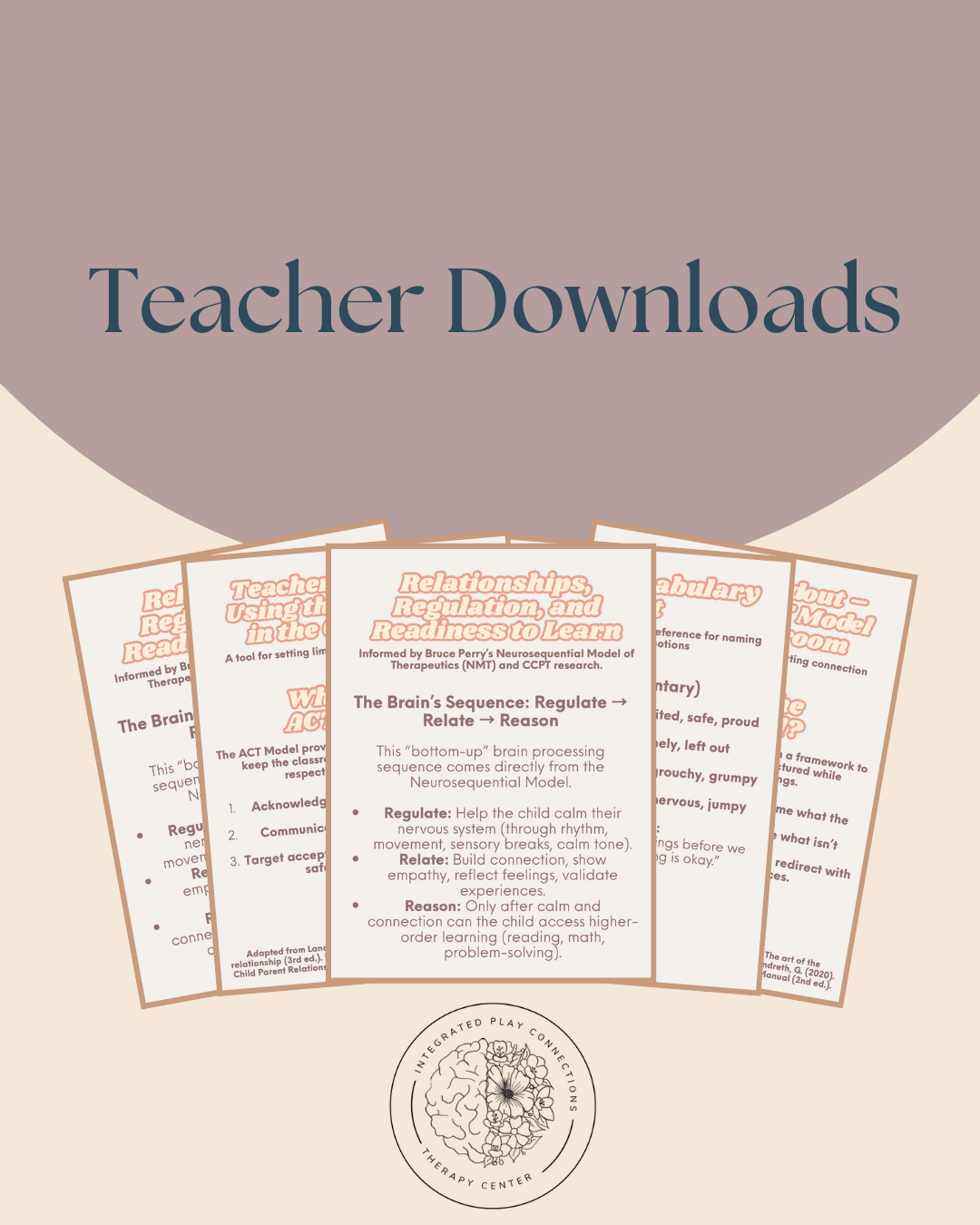 Image 1 of 1
Image 1 of 1


School-Based Support Toolkit: Connection-First Practices
A curated set of quick-reference tools for teachers, school counselors, social workers, and student-support staff. Each download bridges play-therapy principles with classroom realities, helping you respond to behavior through a lens of regulation, relationship, and readiness to learn.
What you’ll get:
Behavior as Communication Cheat Sheet
Decode what student behaviors may be communicating about unmet needs. Includes reflection prompts and supportive strategies that preserve connection while maintaining structure.Classroom Language Quick Guide
Developmentally-attuned scripts for emotion validation, limit setting, and problem-solving—great for teachers, aides, and counselors alike.Co-Regulation Strategies
Quick, low-prep activities for helping students borrow calm through connection, perfect for classrooms, counseling offices, or small-group settings.Collaboration Checklist
A structured framework for strengthening communication between educators, caregivers, and mental-health providers, ensuring consistency across home and school.Connection-Focused Language
Reflective statements to help students feel seen, understood, and safe, effective during conflict, transition, or de-escalation.Daily Connection Rituals
Predictable routines (greetings, check-ins, closings) to foster belonging and emotional safety throughout the school day.Reframing Misbehavior Guide
Shift from punitive responses to curious ones by viewing behavior through a developmental and neurobiological lens. Includes quick examples and reframing prompts.Teacher FAQ: CCPT-Informed Insights
Concise, practical answers to common classroom challenges, meltdowns, shutdowns, defiance, and peer conflict, grounded in child-centered play therapy principles.ACT Model in the Classroom
Learn to apply the Acknowledge–Communicate–Target model for setting compassionate, effective boundaries in group or individual interactions.Relationships, Regulation & Readiness to Learn
A visual reference of Perry’s “Regulate → Relate → Reason” sequence with classroom applications and when-to-use guidance.Feelings Vocabulary Chart
Emotion vocabulary by intensity level, with adaptable prompts for reflection, journaling, or group processing, ideal for SEL programs or counseling offices.
A curated set of quick-reference tools for teachers, school counselors, social workers, and student-support staff. Each download bridges play-therapy principles with classroom realities, helping you respond to behavior through a lens of regulation, relationship, and readiness to learn.
What you’ll get:
Behavior as Communication Cheat Sheet
Decode what student behaviors may be communicating about unmet needs. Includes reflection prompts and supportive strategies that preserve connection while maintaining structure.Classroom Language Quick Guide
Developmentally-attuned scripts for emotion validation, limit setting, and problem-solving—great for teachers, aides, and counselors alike.Co-Regulation Strategies
Quick, low-prep activities for helping students borrow calm through connection, perfect for classrooms, counseling offices, or small-group settings.Collaboration Checklist
A structured framework for strengthening communication between educators, caregivers, and mental-health providers, ensuring consistency across home and school.Connection-Focused Language
Reflective statements to help students feel seen, understood, and safe, effective during conflict, transition, or de-escalation.Daily Connection Rituals
Predictable routines (greetings, check-ins, closings) to foster belonging and emotional safety throughout the school day.Reframing Misbehavior Guide
Shift from punitive responses to curious ones by viewing behavior through a developmental and neurobiological lens. Includes quick examples and reframing prompts.Teacher FAQ: CCPT-Informed Insights
Concise, practical answers to common classroom challenges, meltdowns, shutdowns, defiance, and peer conflict, grounded in child-centered play therapy principles.ACT Model in the Classroom
Learn to apply the Acknowledge–Communicate–Target model for setting compassionate, effective boundaries in group or individual interactions.Relationships, Regulation & Readiness to Learn
A visual reference of Perry’s “Regulate → Relate → Reason” sequence with classroom applications and when-to-use guidance.Feelings Vocabulary Chart
Emotion vocabulary by intensity level, with adaptable prompts for reflection, journaling, or group processing, ideal for SEL programs or counseling offices.



